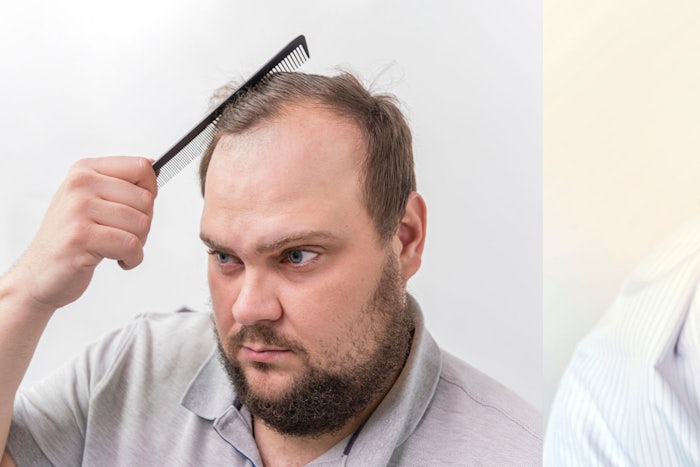Male pattern baldness: What are your options?
If you or someone close to you has experienced emotional distress over thinning or hair loss, there are plenty of viable options to help feel like your best self.
- Jump To Section:
- Hair transplants •
- Hair pieces/wigs •
- Tonics and medicines

As we age, some men begin to experience male pattern baldness, but for older men who wish to regain some of their lost confidence or personal aesthetic, options are available. (Source: Shutterstock)
Key points:
- Hair transplantation (hair plugs) involves taking hair follicles from one part of the body and inserting them into an area of the scalp which is bald, in order to grow new strands
- Wigs are another popular option, with adhesive material to ensure that the piece stays attached to the head
- Alternatively, medicines can be applied to slow the progression of male pattern baldness or try to regrow hair in thinning areas
This edition of Aged Care Guide will cover the available options, respective costs, success rates and professional advice surrounding male pattern baldness. Roughly 80 percent of men are impacted by the condition in one way or another by the time they turn 70.
Male pattern baldness is characterised by a receding hairline and gradual thinning of the head’s crown, eventually leading to a horseshoe-like area of hair growth which is unable to grow hair on top. The condition is related to genetic factors, with other family members serving as relative indicators of whether you may begin to lose hair following the onset of puberty.
According to the Government website Health Direct, one in five men in their 20s, one in three men in their 30s and one in two by their 40s will experience male pattern baldness. However, despite the normal nature of ageing, male pattern baldness may be a mental health crisis for men who feel deprived of confidence, bravado and machismo.
Hair transplants
It is important to discuss any cosmetic surgery procedure with your general practitioner (GP) first. This may help you to determine whether surgery is right for you or how it can be managed post-operation.
Hair transplant surgery is an expensive option, relative to wigs and elixirs, medicines or tonics. The process involves taking active hair follicles from other parts of the body and grafting them (inserting follicles) into the areas without hair. Typically, lighter hair tends to yield better results compared to darker, thinner hair.
Similarly, while hair transplants effectively insert new seeds to grow on the bald areas, the surgery will not prevent progressive balding on other, natural, parts of the head. As a result, your doctor may advise that you manage the procedure and subsequent growth with a medicine or tonic as well, to ensure consistent hair loss prevention.
Hair transplants typically last a few hours, although some patients choose to have different sessions, as up to four thousand follicles may need to be grafted, depending on the severity of hair loss, progress of the condition and nature of the patient’s procedure. Smokers, along with people who may suffer complications as a result of anaesthesia will have to disclose relevant information to the surgeon or medical professionals prior to the procedure, in order to make sure it is successful.
Although clinics and prices vary, the price of a standard hair transplant in Australia ranges from $11,000 – $18,000, with some procedures costing as much as $30,000 depending on the nature of the person’s hair loss. Hair transplants have an average success rate of 90 – 95 percent.
Hair pieces/wigs
If you’re looking to cut costs, save money and save your hairline, the wide world of wigs will be a wonderful way to keep your confidence intact. However, the price of a good hair piece can vary more than that of a transplant. In particular, the method of adhesion to the scalp can burn a hole in the pocket, as prices for professional application tend to cost between $800 to $2,000 dollars.
Typically, clinics will inform the hair piece recipient about maintenance, adhesion, application and removal. However, some may feel insecure about their lack of hair afterwards, as it quite literally covers up the issue of male pattern baldness, rather than addressing it. The upside, however, is that there is no success rate in opting for a hair piece as a solution and it also helps to save money on pesky haircuts.
Tonics and medicines
Tonics, medicines and off-the-shelf treatments are a go-to solution for many men facing the extreme likelihood of male pattern baldness. Despite the fact that hair transplantation can effectively restore what is lost and hair pieces can replace what is no longer there, available treatments can only slow the process.
In Australia, available treatments may include:
- Minoxidil
- Finasteride
- Spironolacton
- Cyproterone acetate
Additionally, websites such as Pilot and The Hairy Pill offer their own solutions to delay the impact of male pattern baldness, but are often unable to list the description of their respective treatments. Strict laws exist in Australia to prevent the unlawful promotion and advertisement of pharmaceutical goods, however, contact resources are available on the respective websites.
Related content:
Packing checklist for older people



![Older people need to add teeth and oral health to their overall health check. [Source: iStock]](https://agedcareguide-assets.imgix.net/news/articles/wp/9_8_2022-dentist-health.jpg?fm=pjpg&w=162&h=124&q=80)
![Allied health professionals can provide vital health and wellbeing services that are very beneficial to older people. [Source: Shutterstock]](https://agedcareguide-assets.imgix.net/news/articles/wp/25_10_2021-Allied-Health.jpg?fm=pjpg&w=162&h=124&q=80)
![It is important to acknowledge the lifestyle changes of a person with dementia to remain inclusive. [Source: iStock]](https://agedcareguide-assets.imgix.net/news/articles/wp/21_9_22_dementia.jpg?fm=pjpg&w=162&h=124&q=80)
![If you’re after government-funded support, you’ll need to be assessed. [Source: iStock]](https://agedcareguide-assets.imgix.net/news/articles/wp/ACATACAS__3010.jpg?fm=pjpg&w=162&h=124&q=80)
![Learning about how much it may cost you to receive aged care will help you to refine your fiscal planning. [Source: iStock]](https://agedcareguide-assets.imgix.net/news/articles/wp/nursinghomecosts__111.jpg?fm=pjpg&w=162&h=124&q=80)


